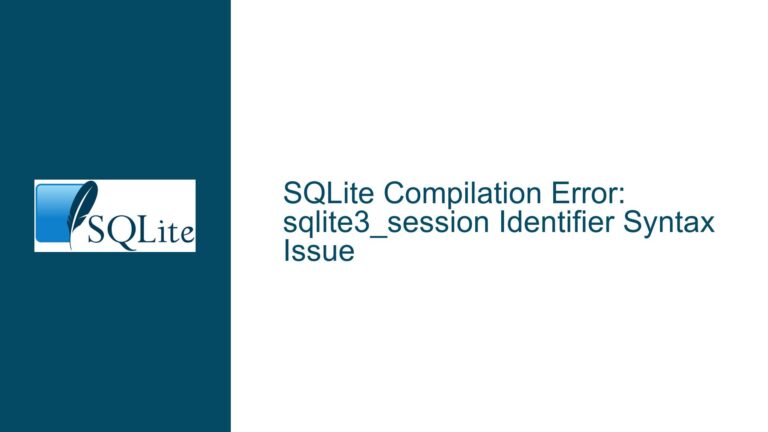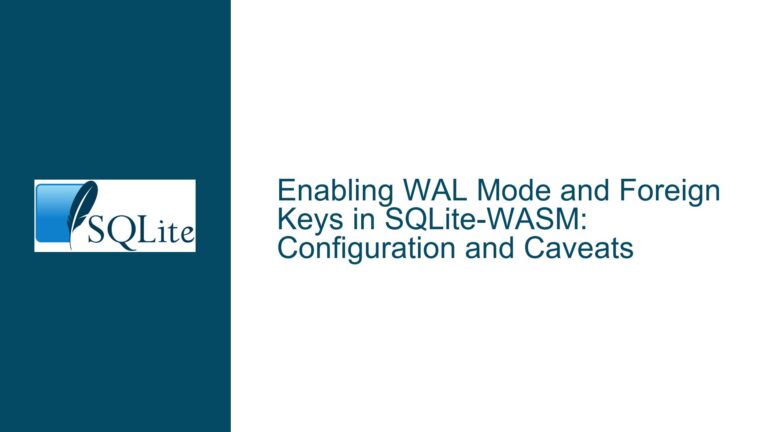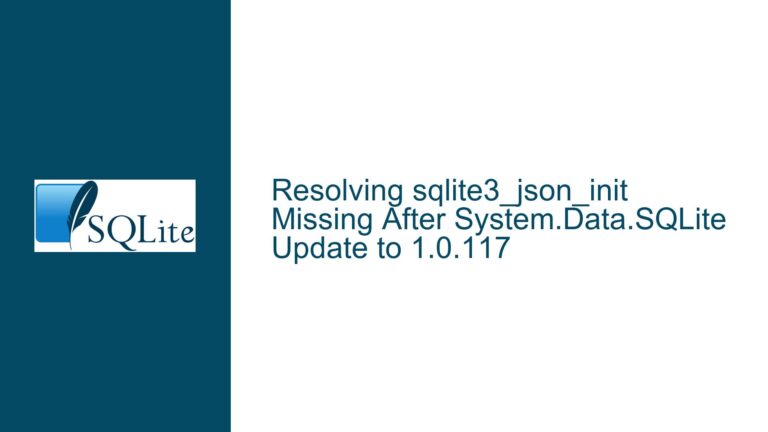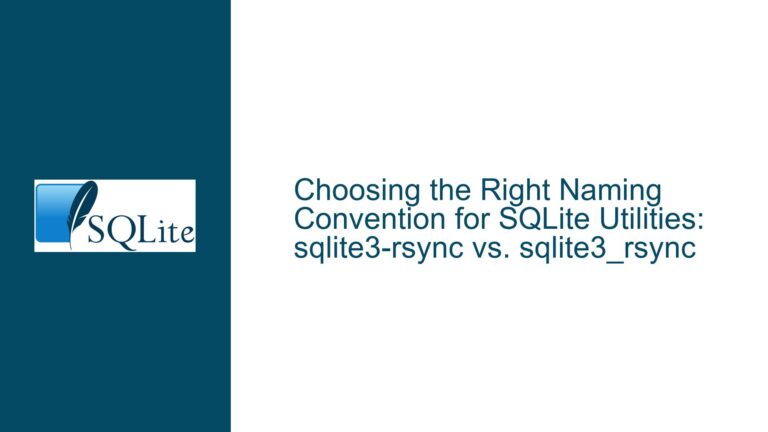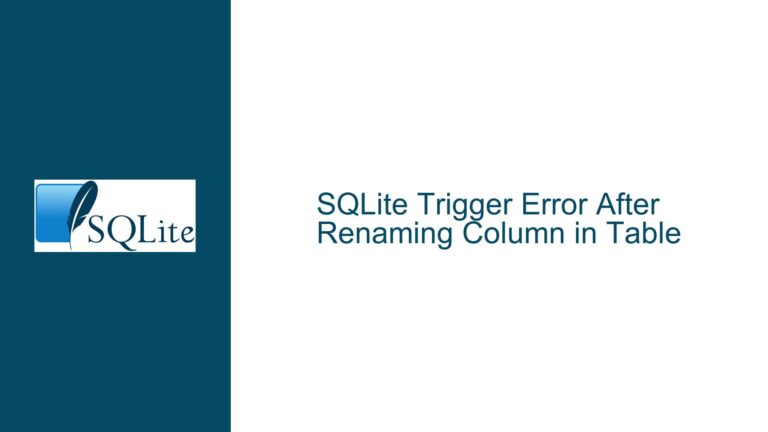ATTACH Command Fails to Create New Database in Custom Code but Works in SQLite Shell
Understanding the Core Behavior Differences Between SQLite Shell and Custom Implementations
The primary issue revolves around the ATTACH DATABASE command’s ability to create new database files in SQLite. When executed in the sqlite3 command-line shell, ATTACH automatically creates a new database file if it does not exist. However, in custom C code using the SQLite API, the same operation may fail with an SQLITE_CANTOPEN error (code 14), indicating the database file cannot be opened or created. This discrepancy arises from differences in how database connections are configured between the shell and custom code, particularly regarding flags passed during database initialization and the internal state management of SQLite connections.
Key Observations From the Problem Statement
Shell Behavior:
Thesqlite3shell implicitly enables database file creation duringATTACHoperations. For example:$ echo "ATTACH '_x' AS x" | sqlite3This creates an empty
_xfile if it does not exist.Custom Code Failure:
A minimal C code example usingsqlite3_open_v2()withSQLITE_OPEN_READWRITE(but notSQLITE_OPEN_CREATE) fails to create the database file duringATTACH, resulting inSQLITE_CANTOPEN.Script Binding Success:
A script binding layer (e.g., a higher-level wrapper) succeeds because it internally addsSQLITE_OPEN_CREATEto the open flags, bypassing the issue.Dependency on Main Database Initialization:
The ability to create anATTACHed database depends on the initialization state of the main database (the database to which the connection is initially opened). If the main database is in-memory (:memory:) or newly created, certain operations (like creating a table) may implicitly alter the connection’s behavior.
Critical Factors Influencing ATTACH’s File Creation Capability
1. Missing SQLITE_OPEN_CREATE Flag on Main Database Connection
SQLite’s sqlite3_open_v2() function requires explicit flags to control file creation. The sqlite3 shell uses SQLITE_OPEN_READWRITE | SQLITE_OPEN_CREATE by default for the main database connection. If SQLITE_OPEN_CREATE is omitted in custom code, the connection lacks permission to create any new database files, including those referenced in ATTACH commands.
Example:
// Failing code (missing SQLITE_OPEN_CREATE):
rc = sqlite3_open_v2(":memory:", &db, SQLITE_OPEN_READWRITE, NULL);
// Working code (includes SQLITE_OPEN_CREATE):
rc = sqlite3_open_v2(":memory:", &db, SQLITE_OPEN_READWRITE | SQLITE_OPEN_CREATE, NULL);
2. Main Database Initialization State
Even if the main database is opened with SQLITE_OPEN_CREATE, SQLite delays file creation until the first write operation. For in-memory databases or newly created files, the ATTACH command may fail unless the main database has been "initialized" (e.g., by creating a table or writing data). This is an undocumented internal behavior that can cause inconsistencies.
Example:
// Without initialization:
sqlite3_open_v2(":memory:", &db, SQLITE_OPEN_READWRITE | SQLITE_OPEN_CREATE, NULL);
sqlite3_exec(db, "ATTACH 'new.db' AS secondary", NULL, NULL, &zErr); // May fail
// With initialization:
sqlite3_exec(db, "CREATE TABLE main.dummy(x);", NULL, NULL, &zErr);
sqlite3_exec(db, "ATTACH 'new.db' AS secondary", NULL, NULL, &zErr); // Succeeds
3. File System Permissions and Path Resolution
While the original issue ruled out permissions, edge cases exist:
- The working directory of the process may differ between the shell and custom code.
- Relative paths in
ATTACHare resolved relative to the process’s current directory, not the main database’s location. - Anti-virus software or file system monitors may intermittently block file creation.
Systematic Diagnosis and Resolution Strategies
Step 1: Verify Open Flags for the Main Database Connection
Action: Ensure the main database connection includes SQLITE_OPEN_CREATE even if the main database already exists.
Why: The ATTACH command inherits file creation permissions from the main connection’s flags.
Code Fix:
// Modify the open flags:
int flags = SQLITE_OPEN_READWRITE | SQLITE_OPEN_CREATE;
sqlite3_open_v2(":memory:", &db, flags, NULL);
Validation:
- After modifying flags, test if
ATTACHcreates the file. - Use
sqlite3_trace_v2()to confirm theATTACHcommand is syntactically identical to the shell’s version.
Step 2: Force Initialization of the Main Database
Action: Perform a no-op write operation on the main database before ATTACH.
Why: Forces SQLite to finalize the connection’s initialization phase, enabling file creation for attached databases.
Code Fix:
// Add a dummy initialization step:
sqlite3_exec(db, "SELECT 1;", NULL, NULL, &zErr); // Non-writing operation
// OR
sqlite3_exec(db, "CREATE TABLE IF NOT EXISTS dummy(x);", NULL, NULL, &zErr);
Validation:
- Check if
ATTACHsucceeds after initialization.
Step 3: Use Absolute Paths and Explicit File Creation
Action: Avoid relative paths and pre-create the database file if necessary.
Why: Eliminates path resolution ambiguities and external factors.
Code Fix:
// Use absolute path:
const char *zNewDb = "/full/path/to/_thingie";
// Pre-create the file if policy forbids SQLITE_OPEN_CREATE:
FILE *fp = fopen(zNewDb, "w"); fclose(fp);
rc = sqlite3_exec(db, "ATTACH ? AS thingie", NULL, NULL, &zErr);
Validation:
- Confirm the file exists before
ATTACHand that absolute paths resolve correctly.
Step 4: Inspect Extended Error Codes and Debug Output
Action: Use sqlite3_extended_errcode() and sqlite3_errmsg() to gather detailed error information.
Why: SQLITE_CANTOPEN has multiple sub-causes (e.g., permission denied, path not found).
Code Fix:
// Enable extended error codes:
sqlite3_extended_result_codes(db, 1);
// After failure:
int extendedRC = sqlite3_extended_errcode(db);
const char *errMsg = sqlite3_errmsg(db);
Validation:
- Check if the error message specifies "unable to open database file" or a more precise cause.
Step 5: Cross-Validate with the SQLite Shell
Action: Replicate the exact ATTACH command and environment in the shell.
Why: Identifies environmental differences (e.g., working directory, file locks).
Procedure:
# In the shell:
.open :memory:
ATTACH './_thingie' AS thingie;
Validation:
- If the shell succeeds where custom code fails, compare open flags and initialization steps.
Step 6: Audit File System Interactions
Action: Use system-level tracing (e.g., strace on Linux) to monitor file operations.
Why: Reveals hidden issues like incorrect paths or permission checks.
Procedure:
strace -e trace=file -o trace.log ./custom_program
Validation:
- Check
trace.logfor_thingiefile creation attempts and associated errors.
Final Solution and Best Practices
Permanent Fix: Always Include SQLITE_OPEN_CREATE for Write Connections
Unless the application explicitly requires the main database to refuse file creation, include SQLITE_OPEN_CREATE in the flags for write-enabled connections. This ensures ATTACH can create new databases without preconditions.
Alternative: Pre-Create Database Files When Necessary
If SQLITE_OPEN_CREATE cannot be used (e.g., for strict schema management), pre-create empty database files before attaching them.
Key Takeaways
- The
sqlite3shell’s default behavior is not neutral—it enablesSQLITE_OPEN_CREATEimplicitly. ATTACHinherits file creation permissions from the main database connection’s flags.- SQLite connections may require initialization (e.g., a write operation) before
ATTACHcan create files.
By aligning custom code with the shell’s implicit configurations and understanding SQLite’s internal initialization requirements, developers can eliminate SQLITE_CANTOPEN errors during ATTACH operations.

